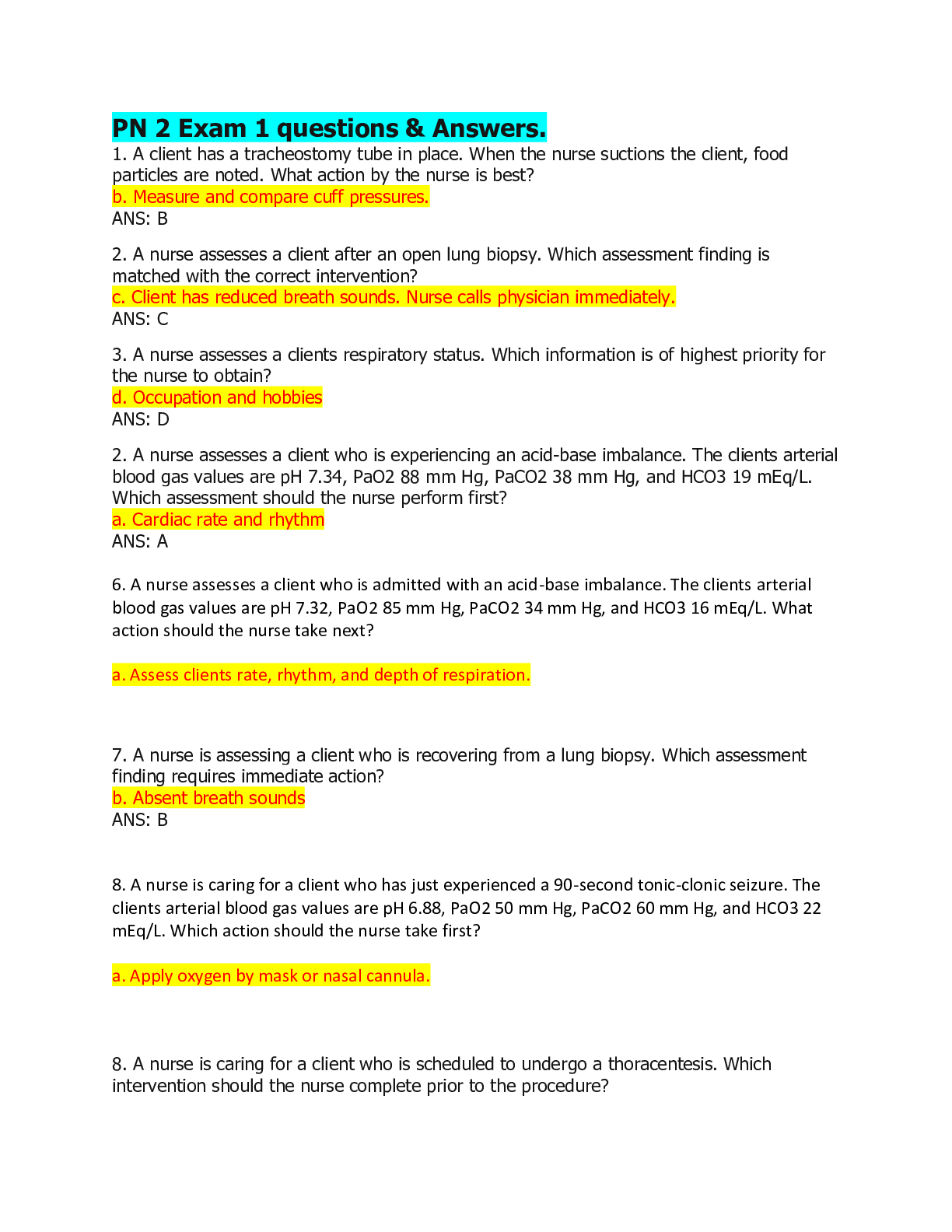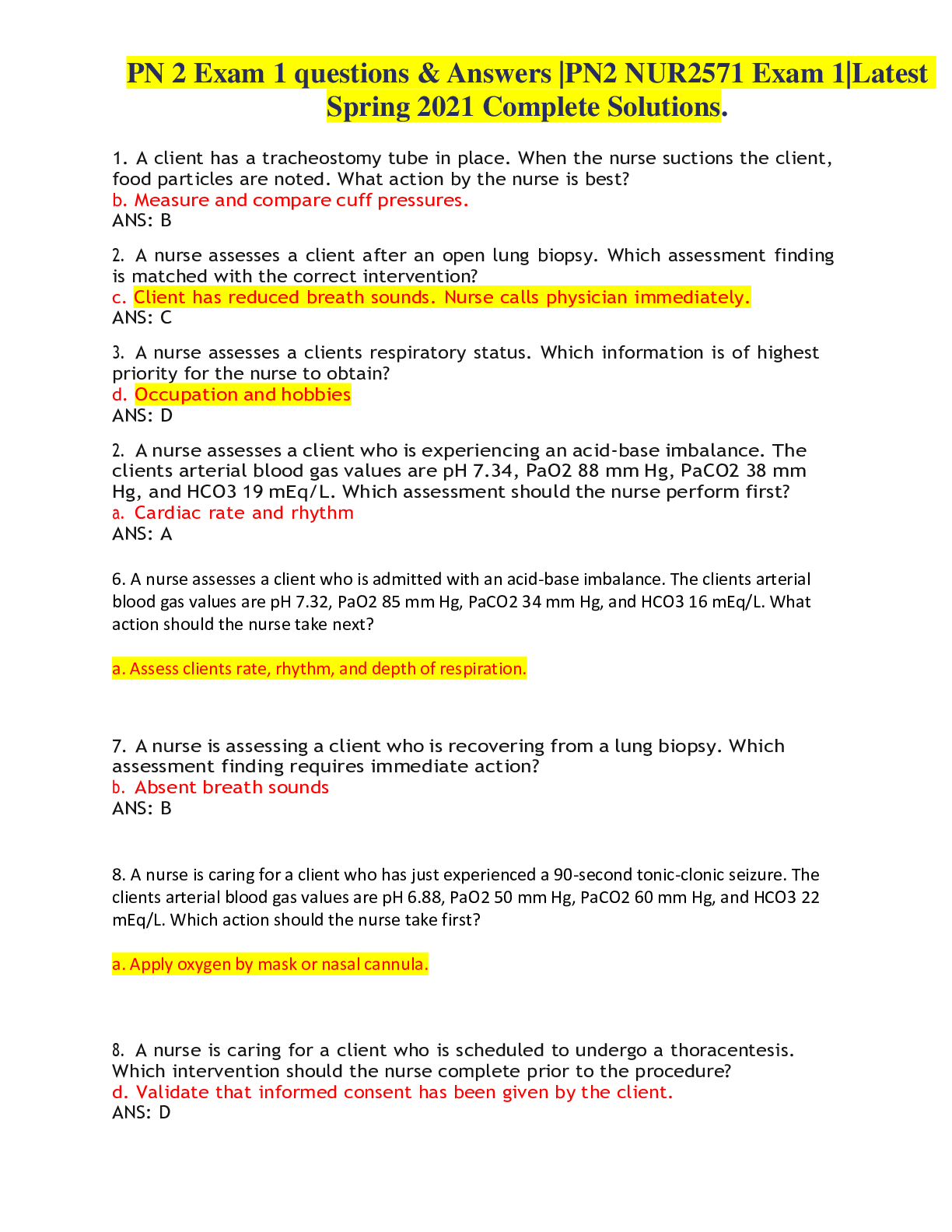*NURSING > QUESTIONS & ANSWERS > PN2 NUR 2571 Exam 1 Questions – Rasmussen College | PN2 NUR2571 Exam 1 Questions – {UPDATED} (All)
PN2 NUR 2571 Exam 1 Questions – Rasmussen College | PN2 NUR2571 Exam 1 Questions – {UPDATED}
Document Content and Description Below
4. A client has a tracheostomy tube in place. When the nurse suctions the client, food particles are noted. What action by the nurse is best? b. Measure and compare cuff pressures. ANS: B 2. A nur... se assesses a client after an open lung biopsy. Which assessment finding is matched with the correct intervention? c. Client has reduced breath sounds. Nurse calls physician immediately. ANS: C 3. A nurse assesses a clients respiratory status. Which information is of highest priority for the nurse to obtain? d. Occupation and hobbies ANS: D 2. A nurse assesses a client who is experiencing an acid-base imbalance. The clients arterial blood gas values are pH 7.34, PaO2 88 mm Hg, PaCO2 38 mm Hg, and HCO3 19 mEq/L. Which assessment should the nurse perform first? a. Cardiac rate and rhythm ANS: A 6. A nurse assesses a client who is admitted with an acid-base imbalance. The clients arterial blood gas values are pH 7.32, PaO2 85 mm Hg, PaCO2 34 mm Hg, and HCO3 16 mEq/L. What action should the nurse take next? a. Assess clients rate, rhythm, and depth of respiration. 7. A nurse is assessing a client who is recovering from a lung biopsy. Which assessment finding requires immediate action? b. Absent breath sounds ANS: B 8. A nurse is caring for a client who has just experienced a 90-second tonic-clonic seizure. The clients arterial blood gas values are pH 6.88, PaO2 50 mm Hg, PaCO2 60 mm Hg, and HCO3 22 mEq/L. Which action should the nurse take first? a. Apply oxygen by mask or nasal cannula. 8. A nurse is caring for a client who is scheduled to undergo a thoracentesis. Which intervention should the nurse complete prior to the procedure? d. Validate that informed consent has been given by the client. ANS: D 9. A nurse assesses a client after a thoracentesis. Which assessment finding warrants immediate action? d. The trachea is deviated toward the opposite side of the neck. ANS: D 1.A nurse is caring for a client who has just had a central venous access line inserted. Which action should the nurse take next? b. Ensure an x-ray is completed to confirm placement. ANS: B 3.A nurse teaches a client who is being discharged home with a peripherally inserted central catheter (PICC). Which statement should the nurse include in this clients teaching? a. Avoid carrying your grandchild with the arm that has the central catheter. ANS: A 5.A nurse is caring for a client who is receiving an epidural infusion for pain management. Which assessment finding requires immediate intervention from the nurse? b. Report of headache and stiff neck ANS: B 7.A nurse is assessing clients who have intravenous therapy prescribed. Which assessment finding for a client with a peripherally inserted central catheter (PICC) requires immediate attention? d. Upper extremity swelling is noted. ANS: D 13.A nurse teaches a client who is prescribed a central vascular access device. Which statement should the nurse include in this clients teaching? c. Ask all providers to vigorously clean the connections prior to accessing the device. ANS: C 14.A nurse is caring for a client with a peripheral vascular access device who is experiencing pain, redness, and swelling at the site. After removing the device, which action should the nurse take to relieve pain? b. Place warm compresses on the site. ANS: B 17.A nurse prepares to flush a peripherally inserted central catheter (PICC) line with 50 units of heparin. The pharmacy supplies a multi-dose vial of heparin with a concentration of 100 units/mL. Which of the syringes shown below should the nurse use to draw up and administer the heparin? ANS: D (10-mL syringe picture) 2.A nurse assesses a client who has a peripherally inserted central catheter (PICC). For which complications should the nurse assess? (Select all that apply.) a. Phlebitis c. Thrombophlebitis ANS: A, C 11. While assessing a client who has facial trauma, the nurse auscultates stridor. The client is anxious and restless. Which action should the nurse take first? a. Contact the provider and prepare for intubation. ANS: A 8.A nurse assesses a clients peripheral IV site, and notices edema and tenderness above the site. Which action should the nurse take next? d. Stop the infusion of intravenous fluids. 3. A nurse assesses a client who has facial trauma. Which assessment findings require immediate intervention? (Select all that apply.) a. Stridor d. Ecchymosis behind the ear ANS: A, D 12. A nurse is caring for a client who is experiencing excessive diarrhea. The clients arterial blood gas values are pH 7.28, PaO2 98 mm Hg, PaCO2 45 mm Hg, and HCO3 16 mEq/L. Which provider order should the nurse expect to receive? b. Sodium bicarbonate 100 mEq diluted in 1 L of D5W 5. A nurse assesses clients on the medical-surgical unit. Which client is at greatest risk for development of obstructive sleep apnea? c. A 55-year-old woman who is 50 pounds overweight ANS: C 7. A nurse cares for a client who is experiencing epistaxis. Which action should the nurse take first? a. Initiate Standard Precautions. ANS: A 2.A client is prescribed 250 mL of normal saline to infuse over 4 hours via gravity. The facility supplies gravity tubing with a drip factor of 15 drops/mL. At what rate (drops/min) should the nurse set the infusion to ANS: 16 drops/min 1.A client is prescribed 1000 mL of normal saline to infuse over 24 hours. At what rate should the nurse set the pump (mL/hr) to deliver this infusion? (Record your answer using a whole number.) ____ mL/hr ANS:42--1000 mL 24 hours = 41.6 mL/hr. (42 is the answer) 12. A nurse is caring for a client who has sleep apnea and is prescribed modafinil (Provigil). The client asks, How will this medication help me? How should the nurse respond? c. This medication will promote daytime wakefulness. ANS: C 2. A nurse assesses a client who has developed epistaxis. Which conditions in the clients history should the nurse identify as potential contributors to this problem? (Select all that apply.) b. Hypertension c. Leukemia d. Cocaine use ANS: B, C, D 3. After teaching a client who [Show More]
Last updated: 1 year ago
Preview 1 out of 16 pages
Instant download

Buy this document to get the full access instantly
Instant Download Access after purchase
Add to cartInstant download
Reviews( 0 )
Document information
Connected school, study & course
About the document
Uploaded On
Apr 10, 2022
Number of pages
16
Written in
Additional information
This document has been written for:
Uploaded
Apr 10, 2022
Downloads
0
Views
82

.png)
.png)
.png)
.png)
.png)
.png)
.png)
.png)
.png)
.png)
.png)




